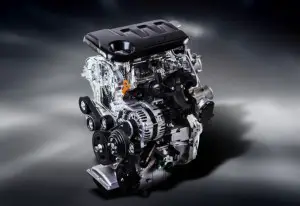DAILY - UPDATED
KIA NEWS
&
SPY SHOTS
REVIEWS
SALES REPORTS

Kia’s 1,0L Turbocharged Engine Detailed – Why Is It So Special
Kia has a new 1.0L three-cylinder TGDI turbo engine to show off, and it is expected to be the first in a line of downsized engines that will be arriving in Europe.
This unit was an in-house job, and was developed by Kia’s powertrain development team in Namyang, Korea.
Engineers had a number of goals when developing the new engine, including delivering immediate response, efficient combustion, and maximum torque at low engine speeds.
It is these three elements that represent the way forward in downsized engines that will eventually make their way into the Kia global lineup.
10% – 15% Better Fuel Efficiency
 When the 1,0L T-GDI engine was in the development phase, engineers hoped to achieve a 10-15% improving in fuel efficiency over the current 1.6-liter GDi engine.
When the 1,0L T-GDI engine was in the development phase, engineers hoped to achieve a 10-15% improving in fuel efficiency over the current 1.6-liter GDi engine.
Among the new features found on the downsized engine is a laser-drilled injector with 6 individual holes.
These holes are arranged in a pyramid shape, thus allowing for a more even spread of fuel and air throughout the cylinder.
With the help of a high pressure pump, the injectors can take the fuel injection pressure all the way up to 200 bar.
The gently curved air intake port found in the current 1.6-liter GDi engine has been replaced by a straight air intake port.
This helps to improve the flow of air to the combustion chamber, which improves fuel efficiency.
At the end of the intake port is a sharper intake throat that is designed to reduce air resistance at every stage of the intake.
The result is a faster, more efficient combustion that suppresses engine knocking.
The single-scroll turbocharger in the T-GDi is paired with an electric waste-gate motor, which improves the performance of the turbocharger.
This unit actively scavenges for fresh air to re-direct back for combustion.
The system delivers immediate engine response regardless of throttle position, greater low-end torque, and improved fuel efficiency, even under high engine loads.
The Cee’ds GT line has a maximum torque of 172 Nm available across a 1,500 – 4,100 rpm range. Maximum power arrives at 6,000 rpm.
Gas temperatures are slightly lowered thanks to the addition of an integrated exhaust manifold.
As well as delivering the aforementioned improvements, the lower temperatures produced means that cleaner emissions are delivered.
A new dual-thermostat split cooling system has been introduced to help regulate engine temperature.
This new system makes it possible for the engine block and cylinder heads to be independently cooled.
The main thermostat controls the flow of engine coolant to the cylinder heads to prevent knocking, while the engine blocks thermostat reduces mechanical friction by shutting off coolant flow above 105°C.
The first vehicle to emply the new 1.0-liter T-GDi engine will be the new Cee’d GT line range, which will arrive in Europe towards the end of the year.
More models are expected to come with the new downsized engine in the coming years.